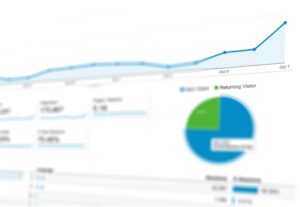Google Analytics is one of the most powerful tools available for website owners, marketers, and business owners to track and analyze website traffic. It helps you understand how visitors interact with your website, where they come from, and what they do once they land on your pages. Whether you’re running an e-commerce site or a blog, Google Analytics provides essential insights to improve your online presence.
In this blog post, we’ll break down what Google Analytics is, how it works, and why it’s important for your website’s success.
What Is Google Analytics?

Google Analytics is a free web analytics tool offered by Google that allows you to track and analyze website traffic. By placing a small tracking code on your website, Google Analytics collects data about your visitors and their behavior. This data is then presented in an easy-to-understand dashboard, where you can gain valuable insights into how your website is performing.
Key Features of Google Analytics

- Traffic Analysis: Google Analytics shows you the number of visitors to your website, how they found you (e.g., through search engines, social media, direct links), and how long they stayed on your site.
- User Behavior: It helps you understand how users navigate your website, what pages they visit, and where they drop off, which is critical for improving user experience and conversions.
- Audience Demographics: You can learn about your audience’s location, language, age, interests, and even the devices they use to access your site. This helps tailor your content and marketing strategies.
- Acquisition Channels: Google Analytics allows you to see where your traffic comes from—whether it’s from organic search, paid ads, social media, or referral links. This helps you focus on the channels that bring the most value.
- Conversions and Goals: You can set up goals in Google Analytics, such as form submissions, product purchases, or newsletter sign-ups. This helps track the effectiveness of your marketing campaigns and measure the return on investment (ROI).
How Does Google Analytics Work?

Google Analytics works by using a small piece of JavaScript code that you embed in the pages of your website. When a user visits your site, this code sends data to Google’s servers. This data includes information such as:
- The user’s location (country, city)
- The page they visited
- How long they stayed on a page
- The actions they took (clicks, scrolls, form submissions)
- Device information (mobile, tablet, desktop)
This data is then processed and displayed on your Google Analytics dashboard, giving you detailed insights into your website’s performance.
Why Is Google Analytics Important?

- Data-Driven Decisions: Google Analytics helps you make informed decisions about your website, marketing strategies, and content. Instead of guessing what works, you can rely on actual data to improve your site’s performance.
- Improves User Experience: By analyzing user behavior, you can identify areas where users are having trouble, such as confusing navigation or slow-loading pages. This allows you to make improvements that enhance the user experience and reduce bounce rates.
- Monitors Marketing Campaigns: If you’re running paid advertising campaigns, Google Analytics helps you track how well these campaigns are performing, including which ads drive the most traffic and conversions. This helps you allocate your marketing budget more effectively.
- SEO Insights: Google Analytics provides information on the search terms visitors use to find your site, which pages are performing well in search rankings, and how your website’s SEO efforts are impacting traffic.
- Tracks Conversions: Whether your goal is to sell products, get newsletter sign-ups, or generate leads, Google Analytics allows you to track these conversions and assess how well your website is achieving its objectives.
How to Get Started with Google Analytics

Getting started with Google Analytics is easy:
- Sign Up: Go to the Google Analytics website and create a free account.
- Set Up Tracking: Once you’ve created an account, you’ll be given a tracking ID. Add this tracking code to the pages of your website (usually in the header section).
- Monitor Your Data: Once the code is added, data will start flowing into your Google Analytics account. You can now access reports and begin analyzing your traffic.
Conclusion
Google Analytics is a vital tool for anyone who owns or manages a website. It offers deep insights into how visitors interact with your site, which helps improve user experience, optimize marketing efforts, and track conversions. By understanding your traffic, you can make smarter decisions and grow your online presence.
